Airfix/Airmodel 1/72 WB-50D
|
KIT #: |
Airmodel 186 |
|
PRICE: |
|
|
DECALS: |
|
|
REVIEWER: |
Carmel J. Attard |
|
NOTES: |
SAC 72013, Xtradecal X032-72 |
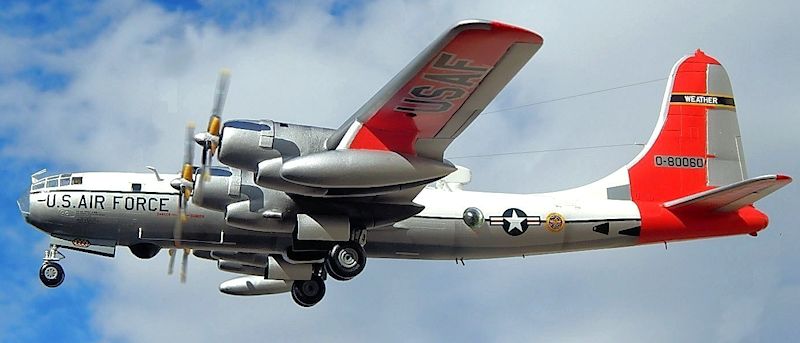
Evolving from the famous B-29 atomic bomber and following a long line of B-50
varieties, the B-50D was the definitive bomber. The underwing tanks introduced
on the B-50B were now jettisonable. 4000Lbs of weapons could be carried in
place of the tanks. The new molded plexiglass nose featured a much larger and
more steep raked flat bombardier’s panel. B-50D eleminated the retractable tail
skid which was a feature of
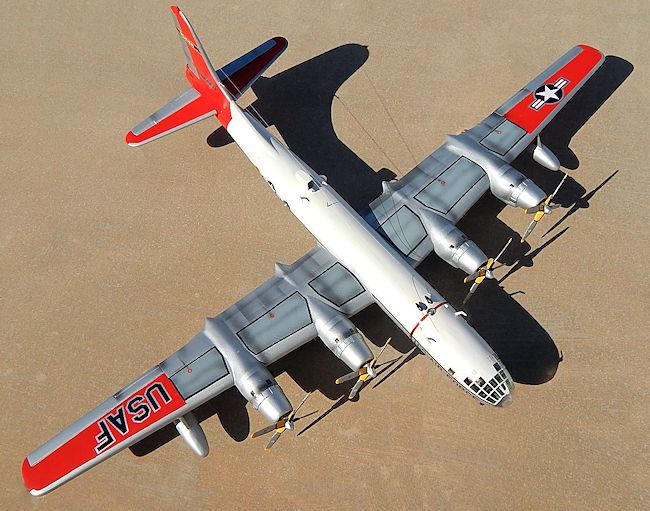 the series since early B-29s.
the series since early B-29s.
Lockheed Air Services in Ontario,California modified 36 B-50Ds into WB-50Ds to
replace the WB-29s in the weather reconnaissance and atmospheric nuclear
sampling roles. In addition to meteorological sensors WB-50Ds carried an
improved air sampling collector in its dorsal “bug catcher”. WB-50s had all
armament deleted and carried the air sampling pod mounted on top. Internally the
bomb bay housed a jettisonable bladder fuel tank capable of holding 10,000
gallons 0f fuel.
WB-50Ds were attached to the 53rd weather reconnaissance squadron.
Initially they were based at Burtonwood. A typical Falcon Delta mission
consisted of flying out of their base at 7.00am daily. The track was 3,686 miles
long and extended from Liverpool to a point 250 miles north of the Azores, then
turns north along the 30th Meridian to a point 420 miles Southeast of
Greenland and finally turned East towards Burtonwood. The mission had an average
flight time of some 15 hours and weather observations being made at fixed points
150 miles apart.
Their missions moved out of Burtonwood, Lancshire, England on the 22nd
April 1959 and upon completng its last mission a WB-50D
landed at RAF Alcombury, Huntingdonshire and became the new home base for
the 53rd WRS. On 10th August
1959 it moved to nearby RAF Mildenhall. Flights out of England were
discontinued on 18th March 1960.
The Airfix B-29 provided the basic kit needed to make the kit conversion
into a B-50. The Airmodel instructions appeared inadequate to follow as even the
sketch of the B-50 drawn on the front page of the instructions showed
the engine exhaust on starboard side of engine cowling instead of port
and the fork antenna located on the nose cap is drawn the wrong way round. Even
so scale plans are not provided .
 The Airfix kit fuselage was first prepared for the initial assembly. Three
positions where the turrets are located were blanked with 6 semi circle plastic
cards which were also slightly bent to take the shape of the fuselage section.
These were fixed using liquid glue. The fuselage interior was then assembled to
kit instructions. A compartment was also added at the back of the crew office
which will contain a piece of lead 1.5” diameter by 0.25” thick. This will
ensure that the model is not a tail sitter. Fuselage interior was painted dark
green zinc chromate which includes the cockpit interior. Printed paper
instruments attached to the consoles, control wheels and seats added and
additional front detail also added inside the nose compartment. These took the
form of junction boxes added close to the floor.
The Airfix kit fuselage was first prepared for the initial assembly. Three
positions where the turrets are located were blanked with 6 semi circle plastic
cards which were also slightly bent to take the shape of the fuselage section.
These were fixed using liquid glue. The fuselage interior was then assembled to
kit instructions. A compartment was also added at the back of the crew office
which will contain a piece of lead 1.5” diameter by 0.25” thick. This will
ensure that the model is not a tail sitter. Fuselage interior was painted dark
green zinc chromate which includes the cockpit interior. Printed paper
instruments attached to the consoles, control wheels and seats added and
additional front detail also added inside the nose compartment. These took the
form of junction boxes added close to the floor.
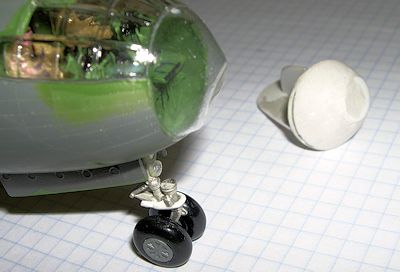 At this stage I modified the SAC
B-29 nose gear so that I could utilise it on the B-50 model. The B-50 introduced
hydraulically-powered nose wheel steering which had a horse–shoe drive located
just above the wheels. The sketch attached shows the upper Airfix plastic kit
part which hinges into the nose and a hole drilled at centre to take the
modified SAC leg. This was a robust kit modification which could definitely
benefit from the sturdy metal undercarriage. The nose leg was
modified to conform with the B-50 type, adding the horse shoe mechanism
and two vertical landing and taxiing lights. The fuselage halves was then closed
and glued together with the nose leg in place.
At this stage I modified the SAC
B-29 nose gear so that I could utilise it on the B-50 model. The B-50 introduced
hydraulically-powered nose wheel steering which had a horse–shoe drive located
just above the wheels. The sketch attached shows the upper Airfix plastic kit
part which hinges into the nose and a hole drilled at centre to take the
modified SAC leg. This was a robust kit modification which could definitely
benefit from the sturdy metal undercarriage. The nose leg was
modified to conform with the B-50 type, adding the horse shoe mechanism
and two vertical landing and taxiing lights. The fuselage halves was then closed
and glued together with the nose leg in place.
The B-50 vertical tail was 5 feet
taller than that on the B-29 due to increase in power provided by the new
engines.
I was not quite happy with
the shape of the vacform tail and this I corrected using part from the B- 29 tail
itself. Airfix fin and rudder were removed using razor saw and the vacform
larger vertical tail added. The B-50 shape has started to emerge. Common on all
WB-50D was the dual ADF “rugby ball” installations on top of forward fuselage.
While the rudder was setting I made a scale drawing of the FOIL “bug catcher"
or so called “dog house” air sampler fitted on fuselage aft spine. This I
scratch built from plastic card. The B-50 nose glazing was the new style that
became standard. This was molded out of clear acetate after a male was prepared
taking the new form clear nose cap….See photo.
29 tail
itself. Airfix fin and rudder were removed using razor saw and the vacform
larger vertical tail added. The B-50 shape has started to emerge. Common on all
WB-50D was the dual ADF “rugby ball” installations on top of forward fuselage.
While the rudder was setting I made a scale drawing of the FOIL “bug catcher"
or so called “dog house” air sampler fitted on fuselage aft spine. This I
scratch built from plastic card. The B-50 nose glazing was the new style that
became standard. This was molded out of clear acetate after a male was prepared
taking the new form clear nose cap….See photo.
Turning to the wing construction this had several areas that differ
completely from the B-29 wings. Airmodel nacelles were separated from backing
plastic. The inboard nacelles were made so that the lower portion of Airmodel
rear 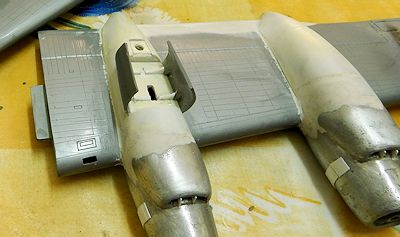 part was mated with the Airfix upper portion already on the upper wing
half. The outboard nacelle was in two halves and were positioned at that same
place as the B-29 outboard engines. The trailing edges of the B-50 wing was
slightly different than those on the B-29, so two new wing trailing edge fillets
were fashioned from scrap plastic and added on. Horizontal tail planes added in
the end and aligned correctly with the fuselage and with respect to the main
planes as viewed from front.
part was mated with the Airfix upper portion already on the upper wing
half. The outboard nacelle was in two halves and were positioned at that same
place as the B-29 outboard engines. The trailing edges of the B-50 wing was
slightly different than those on the B-29, so two new wing trailing edge fillets
were fashioned from scrap plastic and added on. Horizontal tail planes added in
the end and aligned correctly with the fuselage and with respect to the main
planes as viewed from front.
The Airmodel front engine cowlings had an incorrect shape of air intake
and had no option but to discard them. I made a plastic pattern of one cowling
from bits of aircraft spare parts and cast 4 in number aluminium cowlings, this
time with the correct shape of cowls. After fettling and cleaning I also added
two tiny plastic brackets in each of the air intakes.
While I was in the process
of casting I also cas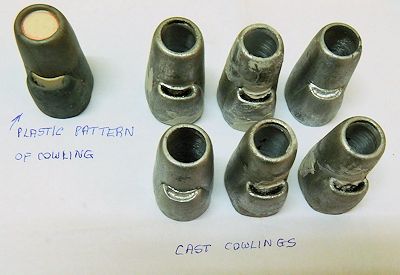 t two underwing fuel tanks and the rectangular radome that
is positioned between the bomb bays. Four propellers were also cast and polished
as these were completely difered from the ones mounted on a B-29. The
hemispherical radome that was attached to the forward fuselage was made out of
putty and shaped in place. All of the parts were now fitted on their respective
place on the fuselage and wings using super glue.Four exhaust pipes were shaped
from sprue piece and drilled on the inside and attached to the port side of each
engine. Cowling gills detail were scratch built from thin plastic card cut in
small squares and attached to each of the engines. When the kit was now all in
one piece, ever sensors and antennas added to the fuselage
as well as two wire antennas from the vertical fin.
t two underwing fuel tanks and the rectangular radome that
is positioned between the bomb bays. Four propellers were also cast and polished
as these were completely difered from the ones mounted on a B-29. The
hemispherical radome that was attached to the forward fuselage was made out of
putty and shaped in place. All of the parts were now fitted on their respective
place on the fuselage and wings using super glue.Four exhaust pipes were shaped
from sprue piece and drilled on the inside and attached to the port side of each
engine. Cowling gills detail were scratch built from thin plastic card cut in
small squares and attached to each of the engines. When the kit was now all in
one piece, ever sensors and antennas added to the fuselage
as well as two wire antennas from the vertical fin.
The B-50 was one of the first large
military aircraft to serve on extended period of time
giving rise to a wide variety of paint appearance and changes that were
necessary to identify the aircraft. I made my pick of WD-50D from the book
“Fighting colours USAF Europe Volume 2 1947-63 in colour” by Robert Robinson.
There is a color side view of the WB-50D belonging to the 53rdWeather
Reconnaissance Squadron (WRS) that was based at Alcombury, Hunts during 1959. I
visited Alcombury twice but that was back in 1969 and
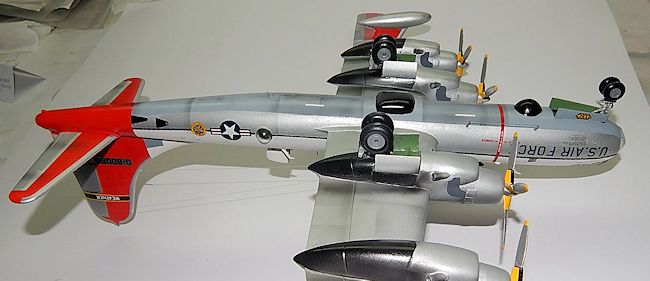 there were RF-4C Phantoms
based there then, all in ADC grey just before they started to wear SEA
camouflage. The B-50s were long gone by then.
there were RF-4C Phantoms
based there then, all in ADC grey just before they started to wear SEA
camouflage. The B-50s were long gone by then.
I made good use of Xtradecal sheet XO32-72 which contained a WB-50D of 53rd
WRS 1956 with a difference that I made a later version of the WB-50D which had
more sensors and
slightly different
colorscheme. My Alcombury based model had the sides in overall natural metal
with an insignia white fuselage crown. This was to mitigate the cabin heating
due to solar radiation. Part of the vertical tail was also painted
white. There is an insignia blue fuselage cheat line that extends as far forward
as the nose perspex. The fin and wing tips were
painted International orange FS12197.
 Further to the colors the control surfaces were protected by aluminized
paint. Upper wing surfaces were natural metal while wing walk ways were gray and
outlined in black. The lower fuselage, nose gear, bay doors were aircraft grey.
Protective area around and aft of combustion heaters on the vertical fin were
also aircraft grey. Lower portion of engine nacelle gloss black but not the main
gear doors which were silver. The blue fin stripe
with yellow border and ‘Weather’ in white
came from the same decal sheet. The decal markings had the 3” aluminium
outline to USAF legend and around national insignia. A new tail radio call sign
I picked from my spare decal box and this was placed on a silver background.
Leading edges of landing gear doors were red. Wheel wells were dark green-tinted
zinc chromate.
Further to the colors the control surfaces were protected by aluminized
paint. Upper wing surfaces were natural metal while wing walk ways were gray and
outlined in black. The lower fuselage, nose gear, bay doors were aircraft grey.
Protective area around and aft of combustion heaters on the vertical fin were
also aircraft grey. Lower portion of engine nacelle gloss black but not the main
gear doors which were silver. The blue fin stripe
with yellow border and ‘Weather’ in white
came from the same decal sheet. The decal markings had the 3” aluminium
outline to USAF legend and around national insignia. A new tail radio call sign
I picked from my spare decal box and this was placed on a silver background.
Leading edges of landing gear doors were red. Wheel wells were dark green-tinted
zinc chromate.
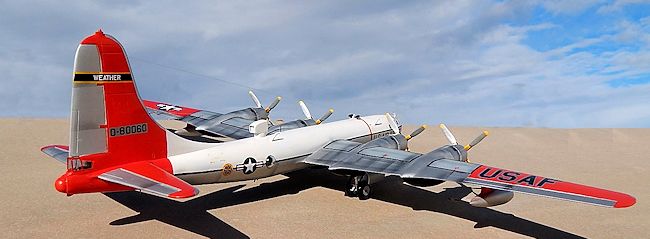 The completed model certainly captures the vivid rugged and massive look
of the WB-50D that gave a stalwart service to America’s air power throughout the
50s.I cannot say it was an easy build but in the absence of an Academy kit of
the B-50 I had no alternative but to make one my way. The conversion was
challenging but enjoyable too and took me the best of past two and a half weeks.
The completed model certainly captures the vivid rugged and massive look
of the WB-50D that gave a stalwart service to America’s air power throughout the
50s.I cannot say it was an easy build but in the absence of an Academy kit of
the B-50 I had no alternative but to make one my way. The conversion was
challenging but enjoyable too and took me the best of past two and a half weeks.
Squadron/Signals Publication USAF Europe Vol2.
Aero Modeler No5 History text on B-50 by Geoff Hays and Jack Morris.
Carmel J.
Attard
March 2014
If you would like your product reviewed fairly and fairly quickly, please
contact
the editor
or see other details in the
Note to
Contributors.
Back to the Main Page
Back to the Review
Index Page


 the series since early B-29s.
the series since early B-29s. The Airfix kit fuselage was first prepared for the initial assembly. Three
positions where the turrets are located were blanked with 6 semi circle plastic
cards which were also slightly bent to take the shape of the fuselage section.
These were fixed using liquid glue. The fuselage interior was then assembled to
kit instructions. A compartment was also added at the back of the crew office
which will contain a piece of lead 1.5” diameter by 0.25” thick. This will
ensure that the model is not a tail sitter. Fuselage interior was painted dark
green zinc chromate which includes the cockpit interior. Printed paper
instruments attached to the consoles, control wheels and seats added and
additional front detail also added inside the nose compartment. These took the
form of junction boxes added close to the floor.
The Airfix kit fuselage was first prepared for the initial assembly. Three
positions where the turrets are located were blanked with 6 semi circle plastic
cards which were also slightly bent to take the shape of the fuselage section.
These were fixed using liquid glue. The fuselage interior was then assembled to
kit instructions. A compartment was also added at the back of the crew office
which will contain a piece of lead 1.5” diameter by 0.25” thick. This will
ensure that the model is not a tail sitter. Fuselage interior was painted dark
green zinc chromate which includes the cockpit interior. Printed paper
instruments attached to the consoles, control wheels and seats added and
additional front detail also added inside the nose compartment. These took the
form of junction boxes added close to the floor.
 29 tail
itself. Airfix fin and rudder were removed using razor saw and the vacform
larger vertical tail added. The B-50 shape has started to emerge. Common on all
WB-50D was the dual ADF “rugby ball” installations on top of forward fuselage.
While the rudder was setting I made a scale drawing of the FOIL “bug catcher"
or so called “dog house” air sampler fitted on fuselage aft spine. This I
scratch built from plastic card. The B-50 nose glazing was the new style that
became standard. This was molded out of clear acetate after a male was prepared
taking the new form clear nose cap….See photo.
29 tail
itself. Airfix fin and rudder were removed using razor saw and the vacform
larger vertical tail added. The B-50 shape has started to emerge. Common on all
WB-50D was the dual ADF “rugby ball” installations on top of forward fuselage.
While the rudder was setting I made a scale drawing of the FOIL “bug catcher"
or so called “dog house” air sampler fitted on fuselage aft spine. This I
scratch built from plastic card. The B-50 nose glazing was the new style that
became standard. This was molded out of clear acetate after a male was prepared
taking the new form clear nose cap….See photo. part was mated with the Airfix upper portion already on the upper wing
half. The outboard nacelle was in two halves and were positioned at that same
place as the B-29 outboard engines. The trailing edges of the B-50 wing was
slightly different than those on the B-29, so two new wing trailing edge fillets
were fashioned from scrap plastic and added on. Horizontal tail planes added in
the end and aligned correctly with the fuselage and with respect to the main
planes as viewed from front.
part was mated with the Airfix upper portion already on the upper wing
half. The outboard nacelle was in two halves and were positioned at that same
place as the B-29 outboard engines. The trailing edges of the B-50 wing was
slightly different than those on the B-29, so two new wing trailing edge fillets
were fashioned from scrap plastic and added on. Horizontal tail planes added in
the end and aligned correctly with the fuselage and with respect to the main
planes as viewed from front. t two underwing fuel tanks and the rectangular radome that
is positioned between the bomb bays. Four propellers were also cast and polished
as these were completely difered from the ones mounted on a B-29. The
hemispherical radome that was attached to the forward fuselage was made out of
putty and shaped in place. All of the parts were now fitted on their respective
place on the fuselage and wings using super glue.Four exhaust pipes were shaped
from sprue piece and drilled on the inside and attached to the port side of each
engine. Cowling gills detail were scratch built from thin plastic card cut in
small squares and attached to each of the engines. When the kit was now all in
one piece, ever sensors and antennas added to the fuselage
as well as two wire antennas from the vertical fin.
t two underwing fuel tanks and the rectangular radome that
is positioned between the bomb bays. Four propellers were also cast and polished
as these were completely difered from the ones mounted on a B-29. The
hemispherical radome that was attached to the forward fuselage was made out of
putty and shaped in place. All of the parts were now fitted on their respective
place on the fuselage and wings using super glue.Four exhaust pipes were shaped
from sprue piece and drilled on the inside and attached to the port side of each
engine. Cowling gills detail were scratch built from thin plastic card cut in
small squares and attached to each of the engines. When the kit was now all in
one piece, ever sensors and antennas added to the fuselage
as well as two wire antennas from the vertical fin. there were RF-4C Phantoms
based there then, all in ADC grey just before they started to wear SEA
camouflage. The B-50s were long gone by then.
there were RF-4C Phantoms
based there then, all in ADC grey just before they started to wear SEA
camouflage. The B-50s were long gone by then.
